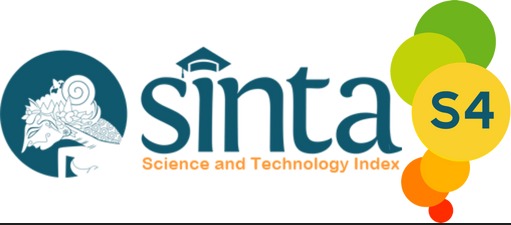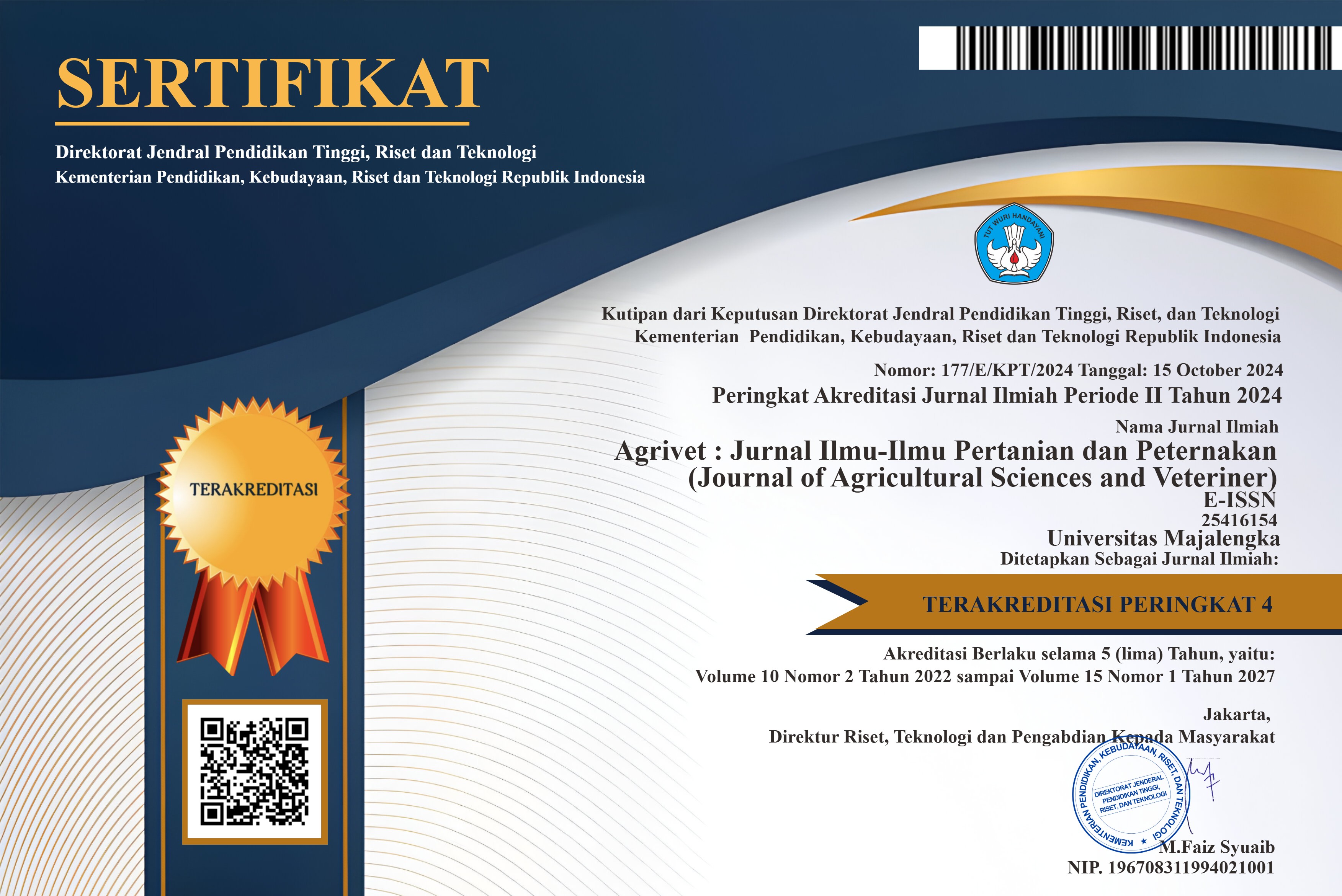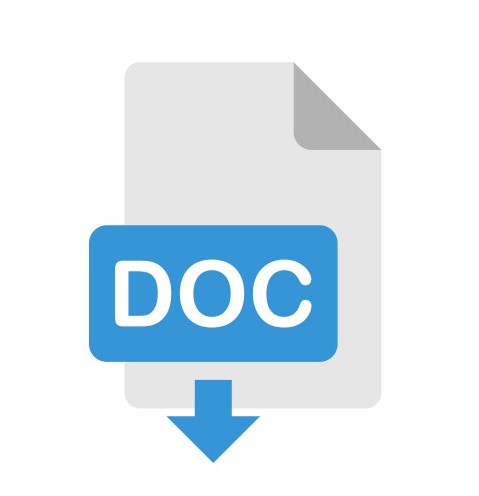Analisis Pendapatan Usahatani Kentang Di Kecamatan Kabanjahe, Kabupaten Karo
DOI:
https://doi.org/10.31949/agrivet.v10i2.3809Abstract
Potatoes are the leading agricultural product in Kabanjahe itself. Under these conditions, Kabanjahe has great potential in terms of agriculture, especially potato plants. The size of a farm's income is influenced by revenue and production costs. However, currently potato farmers in Kabanjahe are faced with a problem, namely the productivity of potatoes that is not yet maximized and the price of potatoes is uncertain, which will affect the productivity and income earned by farmers. This study aims to analyze the income of potato farming. The research was conducted in August 2022. Data analysis used income analysis and R/C ratio analysis. The average income of potato farming in Kaban Village, Kabanjahe District, Karo Regency is Rp. Rp. 29,967,190/ha/MT. The average total cost incurred in potato farming activities is IDR 55,321,810/ha/MT, and the average income in potato farming is IDR 85,289,000/ha/MT. This means that potato farming in Kabanjahe District, Karo Regency is still profitable because farmers' income can still cover the total costs incurred during the production process of the potato farming business.
Keywords:
Income, Farming, Potatoes, Revenue, Production CostsDownloads
References
Apriadi I, Rusman Y, Hardiyanto T. 2016. Analisis Risiko Usahatani Tomat (Solanum Lycopersicum) Varietas Permata (Suatu Kasus di Desa Cibeureum Kecamatan Sukamantri Kabupaten Ciamis). Agroinfo Galuh. 2(3):189-194. DOI: http://dx.doi.org/10.25157/jimag.v2i3.279
Arikunto S. 2014. Prosedur Penelitian Suatu Pendekatan Praktik. Jakarta: Rineka Cipta.
Badan Pusat Statistik. 2020a. Sumatera Utara Dalam Angka 2020.
Badan Pusat Statistik. 2021. Statistik Tanaman Sayuran dan Buah‐buahan Semusim Indonesia 2021.
Badan Pusat Statistik. 2021b. Kecamatan Kabanjahe Dalam Angka 2021.
Budiwan DW, Purba P, Mayly BDachban S. ANALISIS PENDAPATAN DAN KEUNTUNGAN USAHA TANI KENTANG DI KABUPATEN KARO. Wahana Inovasi. 3(1):191-199.
Cahyono. B. 2002. Kentang Tehnik Budidaya dan Analisis Usahatani. Yogyakarta: Kanisius.
Direktorat Jendral Prasarana dan Sarana Pertanian. 2022. Pedoman Pelaksanaan Penyediaan Pupuk Bersubsidi untuk Sektor Pertanian Tahun 2022. Kementrian pertanian, Jakarta.
Harum, 2008. Teknik Budidaya Tanaman. In Budidaya Tanaman Kentang. Direktorat Pembinaan Sekolah Menengah Kejuruan.
Karjadi A. 2016. Produksi Benih Kentang (Solanum Tuberosum L.). Balai Penelitian Tanaman Sayuran (Vol. 9). Bandung: Balai Penelitian Tanaman Sayuran. Petani Kelapa Sawit
Prasetyo B, dan Lina MJ. 2008. Metode Penelitian Kuantitatif. Jakarta: Rajawali Pres.
Rahma SA, & Wulandari E. 2021. Analisis Pendapatan Petani Kentang dan Faktor-Faktor yang Berhubungan dengan Pendapatan Kentang di Kecamatan Pangalengan, Kabupaten Bandung. JEPA. 5(1): 01-12. DOI: https://doi.org/10.21776/ub.jepa.2021.005.01.01
Saputri YS. 2012. STUDI PEMASARAN WORTEL (Daucus carota L.) DI DESA CITEKO KECAMATAN CISARUA KABUPATEN BOGOR JAWA BARAT Marketing Carrot Study (Daucus carota L.) in Citeko Village Cisarua Subdistrict Bogor East Java. EPP. 9(1): 30-34. http://agb.faperta.unmul.ac.id/wp-content/uploads/2017/04/jurnal-vol-9-no-1-yunda.pdf
Soekartawi. 2002. Analisis Usahatani. Jakarta: Universitas Indonesia Press.
Sudarsono H. 2015. Pengantar Pengendalian Hama Tanaman. Yogyakarta:
Plantaxia.
Sugiyono. 2010. Metode Penelitian Kuantitatif Kualitatif & RND. Bandung: Alfabeta.
Sundari MT. 2011. ANALISIS BIAYA DAN PENDAPATAN USAHA TANI WORTEL DI KABUPATEN KARANGANYAR. Jurnal Sosial Ekonomi Pertanian dan Agribis. 7(2):119–126. DOI: https://doi.org/10.20961/sepa.v7i2.48897
Suratiyah K. 2011. Ilmu Usahatani. Bogor: Penebar Swadaya.
Susilo Restu K, & Renda D. 2012. 19 Bisnis Tanaman Sayur Paling Diminati Pasar. Jakarta Selatan: PT Agromedia Pustaka.
Published
How to Cite
Issue
Section
License
Copyright (c) 2022 Dian Hendrawan, Dedi Kusbiantoro, Khairunnisyah Nasution, Yenni Asbur, Nurhayati

This work is licensed under a Creative Commons Attribution-ShareAlike 4.0 International License.
An author who publishes in the Jurnal Agrivet agrees to the following terms:
- Author retains the copyright and grants the journal the right of first publication of the work simultaneously licensed under the Creative Commons Attribution-ShareAlike 4.0 License that allows others to share the work with an acknowledgment of the work's authorship and initial publication in this journal
- The author is able to enter into separate, additional contractual arrangements for the non-exclusive distribution of the journal's published version of the work (e.g., post it to an institutional repository or publish it in a book) with the acknowledgment of its initial publication in this journal.
- The author is permitted and encouraged to post his/her work online (e.g., in institutional repositories or on their website) prior to and during the submission process, as it can lead to productive exchanges, as well as earlier and greater citation of the published work












